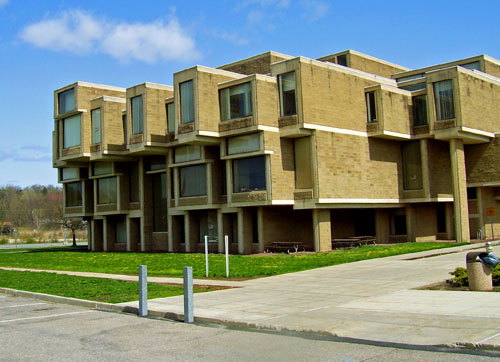- Paul Rudolph (architect)
Infobox Architect

caption =Orange County Government Center in Goshen,New York , designed by Paul Rudolph in 1963, built in 1967
name = Paul Rudolph
nationality =United States
birth_date = birth date|1918|10|23
birth_place =Elkton, Kentucky
current residence =
death_date = death date and age|1997|8|8|1918|10|23
death_place =New York
practice_name =
significant_buildings=Yale Art and Architecture Building
significant_projects =
significant_design =
awards = |:"For other people named Paul Rudolph, see
Paul Rudolph (disambiguation) ."Paul Marvin Rudolph (
October 23 ,1918 in Elkton,Kentucky –August 8 ,1997 in New York,New York ) was an Americanarchitect and the dean of theYale School of Architecture for six years, known for his cubist building designs and highly complex floor plans. His most famous work is theYale Art and Architecture Building (A&A Building), a spatially complex Brutalist concrete structure.Education
Rudolph earned his bachelors's degree in architecture at
Auburn University (then known as Alabama Polytechnic Institute) in 1940 and then moved on to theHarvard Graduate School of Design to study withBauhaus founderWalter Gropius . After three years, he left to serve in the Navy for another three years, returning to Harvard to receive his master's in 1947.Work
He moved to Sarasota,
Florida and partnered withRalph Twitchell for four years until he started his own practice in 1951. Rudolph's Sarasota time is now part of the period labeled Sarasota Modern in his career.Notable for its appearance in the 1958 book, "Masters of Modern Architecture", the
W. R. Healy House , built in 1950, was a one-story Sarasota house built on posts. Theroof was concave, in order to allow rainwater to drain off. In addition, Rudolph usedjalousie window s, which enabled the characteristic breezes to and fromSarasota Bay to flow into the house. Adaptation to thesubtropic alclimate was central to his designs and Rudolph is considered one of the major architects in what is labeled theSarasota School of Architecture .Other Sarasota
landmark s by Rudolph include the Sarasota County Riverview High School, built in 1957 as his first large scale project. Currently, it is slated for demolition despite international criticism [ [http://www.docomomo-us.org/about/threatened_paul_rudolph_riverview_high_school Threatened Paul Rudolph Riverview High School] ] and a great deal of controversy in Sarasota, where many members of the community are appealing for the retention of the historic building since the decision reached in 2006 by the county school board. As Charles Gwathmey, the architect overseeing renovation of Art and Architecture Building atYale , says:Paul Rudolph's Florida houses attracted attention in the architectural community and he started receiving commissions for larger works such as the Jewett Art Center at
Wellesley College . He took over the helm of theYale School of Architecture as its dean in 1958, shortly after designing theYale Art and Architecture Building . That building often is considered his masterpiece. He stayed on at Yale for six years until he returned to private practice. He designed the Temple Street Parking Garage, also inNew Haven , in 1962.He later designed the Government Service Center in Boston, the main campus of
University of Massachusetts Dartmouth (originally known as Southeastern Massachusetts Technological Institute, and later as the Southeastern Massachusetts University), the Dana Arts Center atColgate University , and the Burroughs Wellcome headquarters in North Carolina.While the Brutalist style fell out of favor in the U.S. during the 1970s, Rudolph's work evolved, and became in demand in other countries. Rudolph designed reflective glass office towers in this period, such as the
D. R. Horton , andWells Fargo towers inFort Worth , which departed from his concrete works. Rudolph continued working on projects inSingapore , where he designedThe Concourse office tower with its ribbon windows and interweaving floors, as well as projects in otherAsia n countries through the last years of his life. His work, the Lippo Centre, completed in 1987, is a landmark in the area nearAdmiralty Station ofMTR inHong Kong , and a culmination of Rudolph's ideas in reflective glass. InIndonesia Rudolph pieces of art can be found inJakarta ,Wisma Dharmala Sakti , and inSurabaya ,Wisma Dharmala Sakti 2 .Death
Rudolph died at the age of seventy-eight in New York from
mesothelioma , a cancer that almost always originates from exposure toasbestos .References
External links
* [http://www.paulrudolph.org The Paul Rudolph Foundation]
* [http://prudolph.lib.umassd.edu/ The Paul Rudolph and His Architecture Web Site]
* [http://www.artic.edu/aic/libraries/caohp/rudolph.html Collection] at theArt Institute of Chicago
* [http://www.greatbuildings.com/architects/Paul_Rudolph.html Paul Rudolph] at greatbuildings.com
* [http://architects.arbitat.com/rudolph/ Paul Rudolph] at arbitat.com
* [http://www.nytimes.com/2007/03/23/travel/escapes/23rudolph.html A Road Trip Back to The Future] "; "The New York Times ": account by architecture critic of visits to Rudolph buildings within a day's drive of New York area.
* [http://www.flickr.com/groups/paulrudolph/pool/ Paul Rudolph photo pool at Flickr]
* [http://www.modernpreservation.com Rethinking Preservation: A Case for Paul Rudolph's BCBS Building]
Wikimedia Foundation. 2010.
